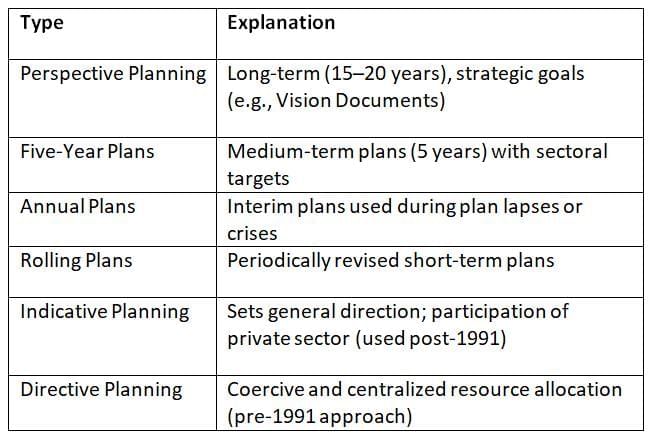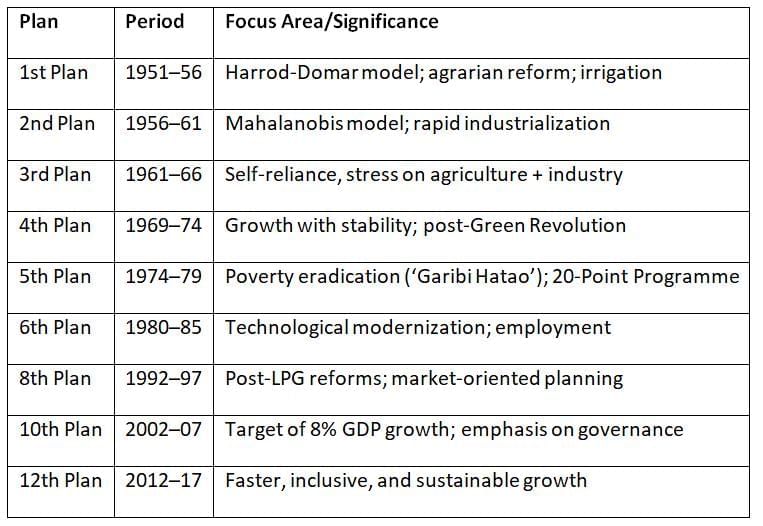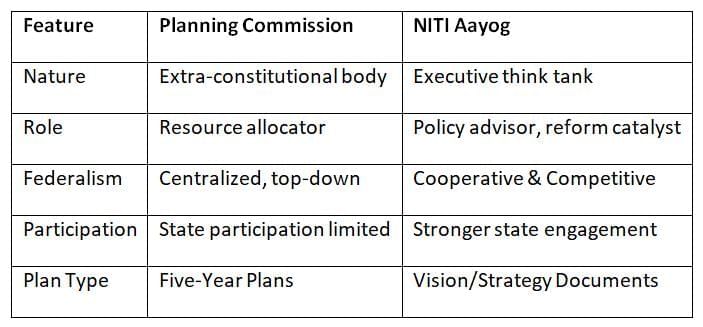UPSC Exam > UPSC Notes > Indian Economy for UPSC CSE > Cheat Sheet: Economic Planning
Cheat Sheet: Economic Planning | Indian Economy for UPSC CSE PDF Download
Concept of Economic Planning
- Economic Planning refers to the deliberate allocation of a nation's resources by the state to achieve specific developmental objectives over a set period.
- Emphasizes coordination, equity, sustainability, and growth—particularly in developing economies.
- In India, planning emerged post-Independence to tackle poverty, low growth, and inequality.
Objectives of Economic Planning in India
- Accelerated Economic Growth
- Reduction of Poverty and Unemployment
- Modernization and Industrialization
- Balanced Regional Development
- Self-Reliance and Import Substitution
- Social Justice and Equity
- Environmental Sustainability
Types of Planning

Institutional Framework

Highlights of Select Five-Year Plans

- Post-2017: Five-Year Plans discontinued; replaced by NITI Aayog’s 3-Year Action Agenda, 7-Year Strategy, and 15-Year Vision Document.
Twenty-Point Programme (TPP)
- Launched: 1975 by Indira Gandhi (revamped in 2006)
- Aims: Eradicate poverty, reduce inequality, support vulnerable sections.
- Monitored by: Ministry of Statistics and Programme Implementation (MoSPI)
MPLADS (Member of Parliament Local Area Development Scheme)
- Initiated: 1993
- Fund: ₹5 crore per year per MP
- Purpose: MPs recommend works of public utility in their constituencies
- Criticism:
- Weak accountability & transparency
- Duplication with state schemes
- Supreme Court upheld its constitutional validity in 2010 (Bhim Singh v. Union of India)
Planning Commission vs. NITI Aayog

Post-Planning Era – NITI Aayog Initiatives
- 3-Year Action Agenda (2017–2020)
- 7-Year Strategy (2017–2024)
- 15-Year Vision Document (till 2030)
Emphasizes:
- Digital India
- Skill development
- Agriculture reform
- Evidence-based policy
- Sustainable Development Goals (SDGs)
The document Cheat Sheet: Economic Planning | Indian Economy for UPSC CSE is a part of the UPSC Course Indian Economy for UPSC CSE.
All you need of UPSC at this link: UPSC
|
108 videos|431 docs|128 tests
|
FAQs on Cheat Sheet: Economic Planning - Indian Economy for UPSC CSE
| 1. What is the concept of economic planning in India? |  |
Ans. Economic planning in India refers to the systematic and organized approach to the allocation of resources to achieve specific economic goals. It involves setting objectives, formulating strategies, and implementing policies to promote economic growth, reduce inequalities, and improve the standard of living. The planning process aims to coordinate various sectors of the economy to ensure balanced and sustainable development.
| 2. What are the main objectives of economic planning in India? |  |
Ans. The primary objectives of economic planning in India include achieving rapid economic growth, reducing poverty and unemployment, ensuring equitable distribution of income and wealth, developing infrastructure, promoting self-reliance, and enhancing the quality of life. Additionally, it aims to stabilize the economy and achieve a balanced regional development across different states and sectors.
| 3. What are the different types of planning used in India? |  |
Ans. In India, economic planning can be categorized mainly into three types:
1. <b>Indicative Planning</b>: Involves setting broad goals and providing guidelines for the private sector, allowing for flexibility in decision-making.
2. <b>Directive Planning</b>: The government takes a more active role by directing resources and investments towards specific sectors.
3. <b>Participatory Planning</b>: Involves the participation of various stakeholders, including local communities and organizations, ensuring that planning reflects the needs and aspirations of the people.
| 4. What is the significance of the Planning Commission and NITI Aayog in India? |  |
Ans. The Planning Commission, established in 1950, was responsible for formulating and implementing five-year plans to promote economic growth and development. In contrast, NITI Aayog was established in 2015 to replace the Planning Commission, focusing on cooperative federalism and sustainable development. NITI Aayog aims to foster innovation and strategic planning by engaging various stakeholders, promoting inclusive growth, and aligning state and central policies more effectively.
| 5. What are the key highlights of the Five-Year Plans in India? |  |
Ans. The Five-Year Plans in India have been crucial for economic development. Some highlights include:
1. <b>First Plan (1951-1956)</b>: Focused on agriculture and irrigation.
2. <b>Second Plan (1956-1961)</b>: Emphasized industrialization and the establishment of a mixed economy.
3. <b>Third Plan (1961-1966)</b>: Aimed at self-sufficiency in food and increased investment in agriculture.
4. <b>Fourth Plan (1969-1974)</b>: Focused on poverty alleviation and employment generation.
5. <b>Fifth Plan (1974-1979)</b>: Introduced the concept of poverty eradication as a priority, emphasizing rural development.
These plans laid the foundation for structured economic development in various sectors.
Related Searches
















